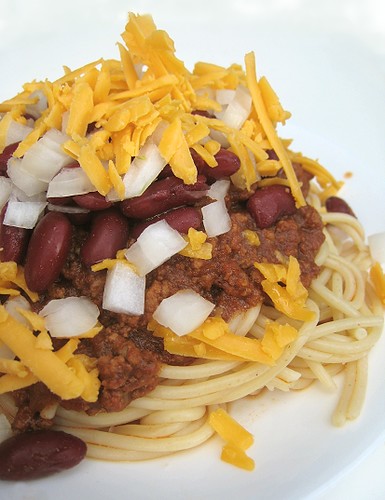
Chili! Let’s talk about Chili! Is it healthy? Can you lose weight on a chili diet? Consider the common ingredients. Meats, Beans and a variety of spices. We have to stop there. Because while most chili recipes share additional common ingredients, such as tomatoes or tomato paste, there are beyond thousands of chili recipes! In fact, some of these recipes DON’T include beans.
Sho Spaeth describes the role of chili in America the best. According to Spaeth:

“Chili is for Americans what Paella is for Spaniards, or Bolognese is for Italians. It seems like everyone knows exactly what they think chili should be, and everyone knows that everyone else is wrong.”
Know Your Chili
What people are generally referring to when they say the word “chili” is chili con carne, a dish made by stewing red meat (either ground, chopped, or left in discrete chunks) in a chili-pepper-based sauce that almost invariably contains cumin.
Origin of Chili
Wow. The origin of chili is highly up for debate. There are numbers of theories out there on who was the first to make this fine dish. Probably the earliest story describes an apparition figure of a Spanish nun appearing to Native Americans in the Southwest region of our country. She shared with natives a fiery red stew made from venison (deer meat), chili peppers, onions and tomatoes.
Another tale tells of Chili Queens in a military plaza based in San Antonio, Texas. The chili was referred to as chili con carne. To keep the chili warm, the Queens built mesquite fires on squares. Meanwhile, customers took turns sitting on wooden stools to eat near colored lanterns that lit the wagons. Its inspiration is thought to have come from Aztec food preparations, especially the Spanish Conquistadors and the use of cumin. Yet, most people agree chili is not a Mexican native dish.
All the stories are simply theories. Yes, each has some fact to support the theory. Ultimately, the origin is unknown.
Gaining Popularity
In 1893, according to old reports, that the chili recipe of Southwestern Texas debuted at the World’s Fair. One San Antonio chili stand was all it took. More Americans were introduced to this warm, flavorful meal. By the 1920’s, its popularity had spread from San Antonio, north and west.
The spread was partially a result of one man, Lyman T. Davis. Mr. Davis was the first person to sell canned chili and became the founder of Wolf Brand Chili. Of course, the availability of pulverized blends of dried chilies, the genius idea of William Frederick Gebhardt, supported the new canned chili innovation. By the time the Great Depression hit, chili established its place among filling meals. It is inexpensive and feeds a family for little expense.
State Chili
I am aware of Texas chili’s. I hear about these on the different food television shows. But Idaho Chili? Being a native Idahoan, this was a surprise to me. Go figure the recipe would include potatoes. After all, that is what Idaho is famous for…our HUGE Idaho russet potatoes. Of course, this recipe is a vegetarian recipe with the option of adding ground beef. Rather than kidney beans, pinto beans or black beans, red lentils are used. The recipe for Idaho Chili is included with my own Chili recipe here.
Is it a Stew?
To clarify, a soup is liquid based. Primarily a broth. The broth can be water or water infused with boiled vegetables or bones. Typically, the protein in a soup cooks in the liquid. A soup remains more liquid with finer chopped vegetables and smaller bites of protein.
According to the theory of the origin from the nun to the Native Americans, it is a fiery red stew. A stew is liquid but much thicker. The liquid can be water or broth based but often is wine or beer based. Occasionally, a stew will have a roux starter. Roux being equal parts fat to flour and cooked until fat is rendered, then liquid is adding to create a sauce or gravy. The meat of a stew generally is braised or slow cooked first and then the liquid and other ingredients added. The bites of meat are a little bigger and the chopped vegetables are chunkier than that of a soup.
Verdict Says Not Soup
I found this article, “IS CHILI SOUP? MAKING SENSE OF THE HOT NEW FOOD DEBATE” By Andy Kryza. An entertaining read on the soup vs stew debate. However, the final verdict comes to the determination of the Vice President of the International Chili Society, Bri Toland. I know, right? Who knew there was an International Chili Society!
“It is the official opinion of International Chili Society that chili is not and should not be considered a soup. True chili is not too thin nor too thick, making it neither a soup nor a stew. Chili is most often served in a bowl, although it should not run (as soup would) if served on a plate or atop chili-marriage favorites such as burgers, hot dogs, or omelets. Bowl or plate; spoon or fork — chili is definitely not a soup.” — Bri Toland, Vice President of the International Chili Society.
Bottom line, chili is too thick to be a soup, too thin to be a stew. Chili is its own category. Chili is chili. Or is it a Chowder? Ha! Nope…not going there. I urge you to recognize soup as soup. Stew is a stew. Chili is chili. And to make life easier, chowder is chowder! Add: Chowder recipe here
Soup du Jour
Ironically, many restaurants and fast food businesses across the nation offer a soup side dish. Often, you will have more than one option; or you will have a soup du jour – which means “soup of the day”. Chicken noodle is usually a classic stand-by. Other favorites include minestrone, beef barley, chicken with wild rice or broccoli cheddar. But somehow added to this list you can almost be guaranteed to find either a chili, a chowder or both. Not a soup, not a stew!
The Bean Debate
As if chili hasn’t presented us with enough to debate, the next big point of contention is with or without beans?
“To bean, or not to bean. When you’re making a pot of chili, that is the question”.
– Lisa Cericola, SouthernLiving.com
According to an article written by Lisa Cericola, Texas natives will tell you definitively NO, but beans are fair game from anywhere else. She shared a couple recipes in her article which I will also share; beef chili and quick-fix chicken chili using a store-bought rotisserie bird, sweet potatoes —and white beans.
While the debate may be whether or not to include the bean in the recipe, it is irrefutable the bean added in is an inexpensive and healthy way to stretch the meal. For many bean proponents, this is the most supportive reasoning for including the funny shaped little edible seed.
Beans by Region
By the mid-1900’s, chili was being served across the country in many forms. Both with and without beans. Different regions have, in fact, implemented their own unique tweaks to the recipes too. As well as how chili is presented. Now, chili is considered a regional dish. In Ohio, chili is served over spaghetti and includes cocoa powder in its sauce flavoring. It is spooned as a no beans meat sauce onto Coney-style hot dogs in Michigan, topped with yellow mustard and onions. And made with green chilies and pork in New Mexico, to name a few.
Beyond stretching the meal, I have yet to find any information identifying any other reason to include or exclude beans from chili. It appears to be a matter of regional preferences. Personal preferences for chili may take over regional preferences someday. People relocating and overall globalization, recipe sharing over the internet. These may transform our beloved chili!
The Chili or The Carne
Interestingly, Jessica Dupuy, author of the cookbook “United Tastes of Texas”, acknowledges the Texas pride when it comes to the origin of Chili. Yet she points out the word chili comes from the word chili con carne, a word derived from South America. This isn’t the first time we have heard this. I have now mentioned this fact three times. Again, chili con carne in its translation from Spanish means chilies with meat. Chilies being the operative word. Jessica claims, “(without chilies) …our modern-day chili would be little more than a boring bowl of sautéed meat.”
Chili by Definition
The ICS defines traditional red and green chili as “any kind of meat or combination of meats, cooked with red chili peppers, various spices and other ingredients, with the exception of beans and pasta which are strictly forbidden. No garnish is allowed.” The other chili competition organization, Chili Appreciation Society International (CASI) to sanction the rules and guideline for competitions adamantly sticks to the traditional definitions too.
Yet after excluding beans and pasta from that definition, ICS’s Homestyle Chili competition defines chili as: “the cook’s favorite combination of ingredients resulting in a dish seasoned with chili peppers and spices.” This relaxed definition of chili allows for beans and pasta and other nonstandard ingredients such as macaroni, rice and hominy.
Chili Categories for Competition
Each chili cook-off sponsored by the ICS must have separate judging categories for “Traditional Red Chili,” “Chili Verde,” “Homestyle Chili,” and, incongruously, “Salsa”; Homestyle Chili is the only category that permits the use of “fillers,” such as beans and pasta.
Thus, despite attempts on the parts of many, including the International Chili Society, to specifically define different styles of chili, there are far more than the three categories it allows into competition.
But does the Homestyle Chili category then count as a secondary reason to include beans? Because it is NOT excluded when the chili in question is created for competition? Bean counters, adding beans to chili to win competitions resulting in more “beans” to count? I tend to think it is still based on stretching the meal or preferences.
Chili Cook-Offs
ICS was the host for the first World’s Chili Championship in 1967 held in Terlingua, Texas. Leading up to that was the continuing popularity of chili. More variations of the bountiful dish were appearing. Backyard chili cook-offs began as church fundraisers, firehouse competitions, at local country fairs. By the 1950s and 1960s, chili cook-offs were widespread, popular and common.
Chili Styles Emerge from Competitions
Chili cook-offs are, of course, competitions and have helped to codify different styles of chili. More recently, chili’s popularity has been driven largely by chili cook-offs. We love our chili. Sharing our own recipe and having people fall in love with our masterful chef-ery, strokes our pride. Plus, cook-offs give us a chance to try other recipes. This inspires us to create more new and exciting versions. I have some great ideas in mind now for some new versions I intend to concoct.
Chili Talk in Congress
Fascinatingly, the popularity for these competitions resulted in a bill introduced to the United States Congress in 1991 proposing chili be the official food of the United States.
In a joint resolution, introduced on September 26, 1991, in the United States Congress by then-Representative James Inhofe of Oklahoma, there are compelling reasons to designate chili the official food of the country.
Convincing arguments from the text of the bill read: “(chili) …is an indigenous American cuisine that was created, refined, and approaches perfection only in the United States”; chili, it went on, “is a succulent, distinctive blending of meats and spices that has economically nourished countless millions of Americans since its inception in the 19th century”; chili, it noted, “embraces the highly individualistic traits of America’s heritage through its infinite varieties, highly personalized blending of ingredients, and many adaptive uses.”
Left Un-official
Prior to the 1991 bill, over the years, a few members of Congress attempted to name chili as the official food of our country. In the 1980’s it was the New Mexico Representative Manuel Lujan Jr. trying to name “chile” the official food, not just chili. In 1988, Texas Representative, J. J. Pickle made his own proposal. His attempt was to make the preferences of the Texas style chili with NO beans as the national favorite.
It didn’t work for everyone and therefore wasn’t passed. For not in any other category of food will you find as many passionate souls debating the fundamental ingredients of a dish. Chili loyalists even debate the spelling of its name. Ultimately, Texas did approve a bill for the State of Texas.
And yet, perhaps these lawmakers were onto something way back when: If there’s anything that current events have shown us, Americans seem to agree that America is great, just so long as it is an America run in the way they want. Regional attitudes about chili appear to be very much the same.
National Chili Day
The biggest boost to the popularity of chili was when U.S. President Lyndon B. Johnson exclaimed his passion for the stew. The White House even sent out copies of the recipe. This was the motivating factor behind Texas establishing itself as the capitol of chili.
The text of the resolution is characteristically spirited: “One cannot be a true son or daughter of this state without having his taste buds tingle at the thought of the treat that is real, honest-to-goodness, unadulterated Texas chili,” it says. The next clause goes further, declaring that only Texans produce the “best and only authentic concoction of this piquant delicacy.” The resolution concludes by saying that “the only real ‘bowl of red’ is that prepared by Texans,” before proclaiming chili the state’s official dish.
Officially, after passing through the legislature in 1977, chili is the Texas State food. Nationally, the fourth Thursday of February is recognized as National Chili Day.
Identifiable Chili Types
Here’s a short list of the types that any aspiring chili expert should know.
Chili Con Carne, a.k.a. Texas Red
The chili that was invented in San Antonio is said to be a bowl of “red”: tender, individual stewed chunks of beef swaddled in a spicy, cumin-spiked sauce made from red chilies, which lends the dish an appealing russet hue. In Texas, it’s not chili unless it’s a bowl of red. The guiding rule is without any question, a filler of any kind, most especially beans, is excluded from chili.
A healthy debate persists over whether tomatoes can be included, and a chili recipe published in the New York Times in January 2015 merited a full-article rebuttal in Texas Monthly, which targeted in particular the inclusion of coriander seed. In the end, the only way you’ll ever know whether something is a true Texas chili is if you’re Texan, at which point you can fight with other Texans about what does and doesn’t go in the dish. For the rest of us, “no beans” is about as definitive as it gets.
Get the recipe for Real Texas Chili Con Carne »
Springfield “Chilli”, the Spelling
Chili in Illinois isn’t chili: It’s “chilli,” with two l‘s. Just like New Mexico debating the spelling of chili should be chile, Illinois has its debate over one or two I’s. Exactly how this debate has seeped into the history of “Chilli” in Illinois is unknown. Speculation of a marketing ploy for a chili parlor to play off the two l’s in Illinois is only challenged by the story of a sign painter who misspelled the word on a sign.
Springfield “Chilli”, the Influencer
According to the ICS, “the only man ever to win the National and the World Chili Championships” was Joe DeFrates. His wins making him a legendary figure in the history of American Chili. It happens to be Joe started serving his signature recipe in Springfield, Illinois, which is deemed the state capital of Illinois. His recipe consists of ground beef, Hunt’s canned tomato sauce, a secret spice mix (includes chili powder), and a dash of Tabasco.
Like Texans, the people of Illinois take their “chilli” seriously. Evidenced by the passage of a joint resolution in 1993 by the Illinois House and Senate officially proclaiming the state “The Chilli Capital of the World”. More controversially, the Illinois General Assembly declared the city of Taylorville, which has a lively chilli cook-off scene, the “Chilli Capital of Illinois” in 2016.
Cincinnati-Style Chili
Mediterranean Influence
The Cincinnati-Style Chili came to be recognized as the uniquely enhanced meat sauce adorning coneys created by immigrant brothers John and Tom Kiradjieff. The base sauce included cumin, beef and some chili pepper. The brothers added paprika, allspice, cinnamon and chocolate. All these additions strongly emphasize the Mediterranean palate. They had immigrated from Greece to New York, eventually landing in Cincinnati in the early 20th century.
A coney is another name for hot dog. Usually, a hot dog on the East, New York specifically, is called a coney. Some trivial information on the origin of the name “coney”. The name “coney” points to the New York origins of the dish. As noted in The Great American Hot Dog Book by Becky Mercuri, the Coney Island Chamber of Commerce banned the use of “hot dog” to describe sausages, due to a negative association with dog meat. Many turn-of-the-century immigrants who passed through New York referred to the emulsified, encased meat solely by that name.
The Ways and The Noodles
Now this style really stunned me. I understand adding chili to a variety of other dishes to create some fabulous, delicious combinations. In my opinion, however, beyond the sauce and main ingredients, how it is served has never defined a chili. Oddly, the Cincinnati-style chili does just that, defines it as chili when most often being served on a bed of spaghetti noodles.
Furthermore, the chili and noodles are just one way of serving chili. There are five ways in total. This is common knowledge for Ohio natives. To order chili, you must indicate the “ways”. It isn’t as simple as ordering a cup or bowl of the soup du jour.
Here are the “five ways” to order Cincinnati-style chili:
1) Chili only
2) Chili and spaghetti
3) Chili, spaghetti and cheese
4) Chili, spaghetti, cheese and beans or onions
5) Five means everything, including both beans and onions.
In keeping with the hyper-regimented ordering style, there are other rules, including how the chili should be served (on an oval plate); how to eat it (one among many: use your fork to cut, not twirl, the spaghetti); and the necessity of developing your own style over time.
Oklahoma-Style Chili
Oklahoma chili is, by all accounts, very similar to the Texas bowl of red. The main exception is that Okies are will almost definitely include beans, sometimes also including masa. According to the Oklahoma Historical Society‘s account of the history of chili, Oklahoma has never met a chili it didn’t like. Oklahomans openly embrace both the Texas and the Cincinnati styles, along with coneys and coney sauce. Oklahoma is a melting pot for chili varieties.
Chile Verde
Chile Verde differs from other smoky red sauce based chilis. The meat primarily used for this version is pork. The sauce is developed from tomatillos and fresh chili peppers and completely abstains from the use of cumin. This is a New Mexico favorite version of chili. New Mexico natives are insistent a Chile Verde isn’t authentic unless it’s made from Hatch chilies —any of a variety of chilies grown in and around the village of Hatch in that state.
One of the defining elements of a true New Mexican Chile Verde is the smoky flavor that comes from roasted Hatch chilies. There is a hint of bitterness and a welcome peppery sweetness. The result is a rich green sauce, fortified by melted fat, surrounding tender chunks of stewed meat. Is your mouth watering yet?
White Chili
White chili is a chili insofar as it contains meat and has a chili pepper base, but it is the one chili that typically includes shredded poultry, either chicken or turkey. Similarly, to Chile Verde, White chili also starts with a base of fresh peppers. Comparatively, the Chile Verde makes no mention of beans. Yet white chili nearly always includes white beans and is typically served with a pile of shredded cheese.
Vegetarian Chili
Vegetarian chili is an innovation that arose from the vegetarianism craze of the 1960s and ’70s. A meat substitute is sometimes used, but adding beans or other vegetables, like sweet potatoes (which contribute not only great flavor to a chili but an interesting texture as well), will often suffice to make a dish that’s every bit as piquant and complex as more conventional chilis. Of course, given that vegetarian chili isn’t a style so much as a meatless variation on the dish, it can be made with a fresh- or dried-chili base, and the only absolute is all forms of meat are excluded.
Carne Adovada
Carne adovada is the only entry on this list that is almost definitively not a chili; it is, in fact, more of a cooking method than anything else. Another version of chili coming from New Mexico, this has a rich, red chili-pepper-based sauce spiked with oregano. Significantly, this version only sometimes utilizes cumin.
It is used both to marinate and stew pork. By doing so, the meat becomes this incredibly tender morsel. Carne adovada is served any number of ways—as a stew, or as a filling for burritos and sopapillas—perhaps outnumbering the many ways in which Americans across the nation enjoy their chili
Chili Ingredients
With the hundreds of thousands of variations of chili recipes, a breakdown of chili ingredients is nearly impossible to specify. However, we can point out there are regularly used ingredients for the chili varieties. The first, typically main ingredient is a meat of some kind. Beef, Pork, Chicken or Game such as Venison, Bison or Elk.
Despite the bean debate, beans are another regular ingredient. But there is an assortment of bean varieties too. Not nearly as many as chili recipes, however, enough that you must include beans in general as being a regular ingredient. Some recipes call for kidney beans, others ask for pinto beans, black bean or navy beans. Believe it or not, black-eye peas are lumped into the bean debate.
A blend of spices which includes dried ground hot peppers, earthy spices such as cumin and tomato paste give the liquid a deep, rich and robust flavor. Again, the variations are vast and not all recipes have one or any of these regular ingredients. It’s best to find a recipe to suit your ingredient and flavor preferences. Oh, and be sure to find a recipe that your heat tolerance can help. There are plenty of pepper types with a major kick!
Chili Toppings
Does the Madhatter wear many hats? Of course! And that is the same with asking if chili can have toppings. Nearly as creative as the types of chili, the toppings can make all the difference in a chili. Frequently, toppings indicate the regional characteristics of the chili. Remember the Cincinnati chili? Okay, the spaghetti noodles aren’t exactly on top of the chili, but its the combination that “tops off” the chili.

Fresh chopped onions and shredded cheddar cheese. A dollup of sour cream can help tame the heat so is a favorite topping for those whose bravery isn’t with their chili. How about trying that squirt of good ol’ yellow mustard? Throw on some bacon. Add oyster crackers, saltine crackers or a cast iron skillet corn bread. Kick up your corn bread a notch and add in pepper jack cheese and green chilies for a superb Southwestern flavor to compliment your chili.
Chili Pairings
A good cup or bowl of chili takes the chill off a cool fall day. It makes a great comfort food on its own. But when you pair chili, it gets even better. One of my favorite pairings is a chili cheese omelet! For breakfast. lunch or dinner. I suggest you make a double or bigger batch of chili. Once your chili is prepared, simply set aside enough to use for a couple different meals.
My family also doesn’t resist a coney dog, slathered in chili. Or the incredibly messy chili burger where the chili just oozes from between the hamburger buns dripping down your hands. Naturally, chili makes a great partner as a baked potato topping or as a sauce over a pile of french fries. Take it a step further and drown them more with a queso cheese. Use the cheese sauce rather than a shredded cheese and sprinkle green onion across the top.
Chili is used in tacos and I have seen a chili lasagna too!
Pair a hearty chili with a hearty red wine!
My Favorite Chili Recipes
I love cooking my chili from scratch. But because I do, it doesn’t always turn out exactly the same. In fact, I have made different chilis over the years before I finally settled on one chili concoction my whole family loves. Friends and neighbors too. The chili recipe I threw together keeping a particular couple of friends in mind that informed me they can’t stand the “heat” of the chili peppers.
My chili making days started with meat, beans and plenty of vegetables. I made it with so many vegetables it was liking having one of everything from the garden. Then I made a chili with less vegetables but thick with garlic, onions and loads of chili powder, Tobasco and hot sauce. It brought on the heat and left a person crying for a glass of milk. Okay, not quite that hot — I am a wimp to a degree too.
Here are a couple chili recipes for you to try. I have my incredible chili concoction recipe for you to try as well. You never know, it may become the favorite of your family!
Soups and Chilis ~ Featuring my Lil’ Smokie Chili – is here!
Chili at the Oscars
With my adventures in chili cooking, how could I possibly forget about a white chili? This one has a good back story. To condense the story, we had an Oscar Party and the deal was everyone had to bring a dish. But there are rules regarding the dish you bring. First, it has to be a dish you have NEVER made before this. Second, the dish had to tie into one of the nominated categories or film titles or actor names. Third, the dish or its ingredients had to make sense.
One year someone brought a rice dish called: “Passion of the Rice” (Passion of the Christ). Another one was a dessert: “The Eternal Calorie of My Behind” (The Eternal Sunshine of My Mind). You get the idea. Well, my white chili became: “Crouching Chili, Hidden Bean”. The best part was my cousin calling me the next day to inform me his couch had found the “hidden bean”. He said he used nearly a whole can of Febreeze. What can I say? It happens!
Chili for Crowds
Tailgating is another great reason for serving up a chili. Fall season, the days are shorter and the morning and evening air is crisp. It’s sweater time and football season. Chili is such an easy one-pot way to feed several people. Set up a CHILI BAR with a variety of toppings and a few pairing ideas. Everyone can dish up their own chili and dress it to their heart’s content. Yet it’s filling, good for you (most recipes), and when using beans can spread out the meal for pennies. I sometimes wonder if Americans should change Thanksgiving Day to include a batch of regional chili. We never have leftover turkey. Add chili for that filler. Wow! Talk about a food coma! Then again, Super Bowl Sunday isn’t officially a holiday, YET, but chili can be the “turkey” for the Super Bowl Sunday!
Choosing Healthy Chili Recipes
The best part about chili is exactly as we have been discovering. It is the vast amount of chili recipes. There are recipes laden with heavy caloric ingredients and high fat. Think pork sausages, kielbasas, cream bases, loads of cheese — cream cheese! But we can choose a recipe that is lean meat, such as ground turkey, beans, onion and fire-roasted tomatoes. Add in a bell pepper or green chilies. Then we choose anything in between. A day of loaded chili for splurging followed by days of vegetarian chili.
A Chili Diet Challenge
Clearly, we have covered all aspects of chili. Now that you know so much more about chili, do you believe you can eat a different chili every day or every other day and not tire of chili? I hope you are nodding your head yes. I believe it is very possible. However, making a batch of chili can take some time. I mentioned earlier it is a good idea to make a large batch so you can utilize the chili in many ways. In this case, using the extra chili as part of a pairing or as the “chili of the day”. But can you eat chili for two weeks? Nothing else, just chili?
Being mindful of any toppings or pairings, select healthy ingredients to make a few different recipes. Freeze individual servings to make it easier for portioning and to keep the chili from souring. Put yourself on a scale and write down your starting weight. Then, by yourself or with a spouse or a friend, take the chili diet challenge. Restrict your diet to include only different chilis — or the same one if you love, love, love the chili recipe you have written down. Do this with a couple friends and each one makes one batch of different recipes; easier for everyone. Fun too!
Responsible Dieting
The idea of this chili diet is simply an approach using healthy ingredients for a comfort food. There is no official study or proven results for anyone on a chili diet. As with all diets, it is strongly encouraged you consult with your medical provider before you begin a change in your dietary habits.
Other diet products are available on this website as well. From offers for cookbooks with healthy recipes, to healthy snacks delivered to your door to the new coffee that promotes weight loss. Find more information on the Health & Fitness page and the Cooking, Food & Wine page.
Visit all our categories and pages of Madhatter’s Magnificent Market!
Return to the HOME PAGE to decide which category to shop next!
Special thank you to the following for providing helpful resources: https://www.thrillist.com/eat/nation/is-chili-a-soup-we-settled-the-debate, https://www.southernliving.com/dish/chili/chili-recipe-debate-with-or-no-beans, https://www.seriouseats.com/2017/02/guide-to-chili-styles-types-of-chili-recipes.html











